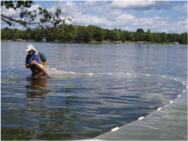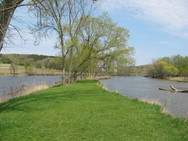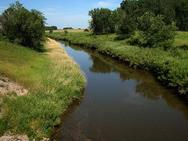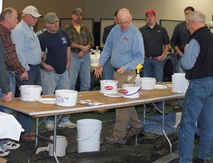
The Minnesota Legislature recognized the
need to protect the state’s environment even before there was an Earth Day
or even a federal environmental agency. The Legislature gave authority to the Minnesota
Pollution Control Agency (MPCA) to begin controlling pollution problems in
the state three years before the first Earth Day and the creation of the EPA.
Protection of water resources actually
started in 1945, when the Legislature established the Water Pollution Control
Commission to encourage communities to build wastewater treatment plants because
too many communities dumped raw sewage into lakes and rivers,
Then in 1962, Minnesota witnessed two of
the most catastrophic oils spills in the history of the state:
- In December, sub-zero temperatures caused a pipeline break at Richards Oil in Savage. The ruptured line released a million gallons of oil into the Mississippi River. Shortly thereafter, a storage tank at the Honeymead plant in Mankato burst, releasing more than 3 million gallons of soy oil onto the ice of the Minnesota River. Oil from both spills slowly traveled downstream.
- With the spring thaw, tragic results were evident. Governor Rolvaag activated the National Guard to coordinate cleanup (a project known as Operation Save-a-Duck), and citizens volunteered to rescue and
rehabilitate oil-covered ducks. Unfortunately, it was not enough. The survival
rate of oil-covered ducks was dismally small. Despite everyone’s best
efforts, more than 10,000 waterfowl and countless beaver, muskrats, turtles,
and fish died.
In 1967, to address the variety and
complexity of environmental problems, the Legislature replaced the Water
Pollution Control Commission with the MPCA and added authority over air
pollution and solid waste disposal.
It
was also a spill that led to the first Earth Day. In
1969 U.S. Sen. Gaylord Nelson of Wisconsin conceived the idea of Earth Day
after witnessing the ravages of a massive oil spill in Santa Barbara,
Calif., according to the Earth Day Network. Inspired by the student
anti-war movement, he marshaled forces – including a Republican – to launch a
national “teach-in” on the environment in 1970.
“As
a result, on the 22nd of April, 20 million Americans took to the streets,
parks, and auditoriums to demonstrate for a healthy, sustainable environment in
massive coast-to-coast rallies. Thousands of colleges and universities
organized protests against the deterioration of the environment. Groups that
had been fighting against oil spills, polluting factories and power plants, raw
sewage, toxic dumps, pesticides, freeways, the loss of wilderness, and the
extinction of wildlife suddenly realized they shared common values,” the
website reads.
“Earth
Day 1970 achieved a rare political alignment, enlisting support from
Republicans and Democrats, rich and poor, city slickers and farmers, tycoons
and labor leaders. The first Earth Day led to the creation of the United States
Environmental Protection Agency and the passage of the Clean Air, Clean Water, and Endangered Species Acts.”
Today,
citizens are again taking to the streets, parks and auditoriums, this time to
support science, important safeguards already in place, and existing funding
levels:
As the MPCA celebrates 50 years, the
variety and complexity of environmental problems has changed; however, our
vision remains the same: Clean water, air and land support healthy communities
and ecosystems, and a strong economy in Minnesota. As the stories below attest,
the agency and its partners work to solve environmental problems every day.
|

Proposals for funding 2018-19 projects are due May 26 at 4
p.m. to the Lessard-Sams Outdoor Heritage Council which
recently issued its request for 2017-‘18 funding proposals. The
council expects about $100 million to be available for projects that protect,
restore and enhance wetlands, prairies, forests, and habitat.
The minimum request is $400,000. (Proposals
less than $400,000 should be submitted to the Conservation Partners
Legacy Program, which opens Aug. 1.) Council staff are available to assist
applicants. For help with writing proposals, contact Sandy Smith by email
or phone at 651-297-7141 to set up an appointment.
The
council makes annual recommendations to the Minnesota Legislature on
appropriations from the Outdoor Heritage Council, which is funded by the Clean
Water, Land and Legacy Amendment.
Meanwhile, some legislative
proposals that affect the Lessard-Sams council are causing controversy, as reported
by the StarTribune:
|

Lakes and streams in the Pine River
watershed in north central Minnesota are considered
very healthy, though some work is needed to protect water quality and restore two
lakes, according to recent studies by the Minnesota Pollution Control Agency
(MPCA).
The Pine River begins at Pine Mountain Lake in Cass County, and flows southeast into Crow Wing County, where it drains into the Mississippi River, about 10 miles north of Brainerd.
The agency and local partners is seeking comments from
the public on the two reports through May 10.
The first report, known as Total
Maximum Daily Load, or a TMDL, establishes the amount of each pollutant
that a waterbody can accept and still meet water quality standards. The TMDL
report identifies phosphorus runoff as a major contributor to water quality
impairments in Jail and Kego lakes.
The second report, known as a Watershed
Restoration and Protection Strategy, or WRAPS,
summarizes past efforts to monitor and improve water quality, and identifies
future strategies for restoring and protecting water quality in the watershed.
Some of the recommended strategies include:
- Protecting existing forestland
- Creating buffers in existing agricultural and developed areas
- Restoring wetlands that have been altered
- Promoting agricultural practices to reduce livestock waste in lakes and streams
- Ensuring septic systems are compliant throughout the watershed
Comments, which must be in writing, may be
submitted to Scott Lucas, MPCA, 7678 College Road, Baxter, MN, 56425, or by
email to, scott.lucas@state.mn.us by 4:30 p.m. on May 10.
For more information, contact Lucas at 218-316-3874, or toll-free at
800-657-3864.
Comments must indicate whether they pertain
to the Pine River Watershed TMDL or WRAPS report. They should clearly state the
action you wish the MPCA to take, including references to sections of the
report that you believe should be changed; and provide specific reasons supporting
your position.
|

According to a recent report from the MPCA and its
partner, the Ramsey-Washington
Metro Watershed District (RWMWD), parts of this metro
watershed are polluted as a result of stormwater runoff, internal loading, and
streambank erosion. In two lakes and two streams, pollution may inhibit
recreational activities, harm aquatic insects and fish, or cause high levels of
E. coli bacteria,
which can be harmful to human health.
The MPCA has published a set of two reports on the watershed,
and is seeking comments from the public on both. The first report, known as a Total
Maximum Daily Load, or TMDL, establishes the amount of each pollutant that
a water body can accept without exceeding water quality standards, and
pollutant load reduction goals.
The second, known as a Watershed
Restoration and Protection Strategy, or WRAPS, summarizes past efforts to
monitor and improve water quality, and identifies future strategies for
restoring and protecting water quality in the watershed.
The RWMWD is located in eastern Ramsey County and western
Washington County and encompasses portions of a number of communities including
White Bear Lake, Vadnais Heights, Gem Lake, Little Canada, Maplewood, Landfall,
North St. Paul, St. Paul, Oakdale, Woodbury, Roseville and Shoreview. The MPCA,
RWMWD and local groups are recommending a number of actions including:
- Reducing streambank erosion
- Reducing in-lake nutrients
- Improving stormwater management to restore and protect
waterbodies
Comments on the reports should be submitted in writing by
May 3 to Brooke Asleson, MPCA, 520 Lafayette Road North, St. Paul, MN
55155-4194, or brooke.asleson@state.mn.us. Asleson is available to answer questions at 651-757-2205.
Comments must indicate whether they pertain to the WRAPS
report or TMDL study. They must include a statement of the action you wish the
MPCA to take, including specific references to sections of the report that you
believe should be changed, and specific reasons supporting your position.
|
The U.S.
Environmental Protection Agency recently approved TMDLs for the Yellow
Medicine, Mustinka and Redeye river watersheds:

Yellow Medicine:
Most of streams, lakes impaired for swimming, fishing
Generally, most
of the streams and lakes in the Yellow
Medicine River watershed do not safely or adequately support swimming or
fishing. Streambank erosion and stormwater runoff are having a negative effect
on water quality. Agricultural activities in the watershed have resulted in
runoff that carries excess phosphorus, sediment and bacteria into bodies of
water.
These pollutants
degrade water quality and are harmful to fish and other aquatic life.
In the watershed’s
TMDL report, and also the WRAPS report approved by the MPCA in 2016, the
agency, local watershed district, and other groups recommend a number of
actions to restore and protect water bodies here.
The watershed is
located in southwestern Minnesota in major portions of three counties: Yellow
Medicine, Lincoln and Lyon, and smaller portions of Lac qui Parle and Redwood
counties. The Yellow Medicine is a major tributary of the Minnesota River,
entering about 8 miles southeast of Granite Falls.
|

Mustinka: Waters
impaired by phosphorus, low dissolved oxygen and sediment
According to the
TMDL report, lakes and streams in the Mustinka
River watershed are polluted with excess nutrients (including phosphorus),
low dissolved oxygen, and sediment that causes cloudiness in the water. In some
areas, the pollution is severe enough to be harmful to aquatic insects and fish
in the water bodies.
The Mustinka
River Watershed lies within the headwaters region of the Red River Basin.
Encompassing an area of 909 square miles, the watershed lies within a flat area
of west central Minnesota used predominantly for agricultural row crop
production.
The TMDL report
and associated WRAPs (approved by the MPCA in 2016) outline several strategies
to restore lakes and streams in the Mustinka watershed.
|

Redeye: TMDL
report targets high bacteria counts
The TMDL report,
developed by the MPCA and local partners, focuses on restoring and protecting
water quality from high bacteria levels in the Redeye River
watershed in central and west central Minnesota.
The Redeye River
watershed covers nearly 900 square miles and includes all or parts of Becker,
Otter Tail, Todd and Wadena counties.
The TMDL report
and WRAPS (approved by the MPCA in 2016) include strategies such as nutrient
management, protecting existing riparian habitat, and increasing forest
acreage.
|

As irrigation for cropland has increased in central
Minnesota, so too has the need for educating producers on managing irrigation
and nitrogen. The groundwater in this part of the state is sensitive to
pollution, making irrigation and nitrogen management crucial to prevent
contamination of drinking water. Nitrate in drinking water can be harmful to
humans, especially infants and the elderly. Nitrate can also be toxic to fish
and other aquatic life.
To meet the educational needs, the Minnesota Department of
Agriculture (MDA) and the East Otter Tail Soil and Water Conservation District (SWCD) have
partnered to offer irrigation and nitrogen management seminars to local
producers. Since 2011, more than 450 producers have attended 11 winter
seminars. The response from participants has been positive and attendance to
the annual event has grown each year. In 2017, more than 100 producers attended.
The successful partnership is funded in part by the Clean
Water Fund, and is providing educational opportunities to both new and
experienced producers in the region.
The Central Minnesota Irrigators group and area SWCDS have
also helped to make these seminars successful. Past seminars have included presentations
from MDA, University of Minnesota Extension, North Dakota State University,
Oklahoma State University, University of Nebraska, Minnesota Department of
Natural Resources, as well as local Natural Resources Conservation Service and
SWCD staff. Topics have included regional groundwater resources; irrigation
scheduling; soil moisture assessment; crop nitrogen use recommendations; and
review of the state’s Nitrogen Fertilizer Management Plan.
The next seminar will be held in February 2018 with more
details announced closer to the event.
For more information, contact Luke Stuewe, MDA Soil
Scientist, at 218-850-9454 or luke.stuewe@state.mn.us.
|
- April 22: Tour Around Lake George, River Falls, Wis. (part of St. Croix Summit)
- April 22: Earth Day festival, Prairie Woods Environmental Learning Center, Spicer
- April 22: Best ways to celebrate Earth Day in Minnesota on WCCO
-
April 22: Earth Day planting event, Great River Greening, Wayzata
- April 22 and beyond: Friends of the Mississippi River volunteer opportunities
- April 22 and beyond: Minnesota Waters calendar of events
- April 25 and May 24: “The Death of Life of the Great Lakes,” Dan Egan, writer, U of M-St. Paul and Duluth
-
April 26: MS4 Permit-Inspections workshop, Willmar Conference Center
|